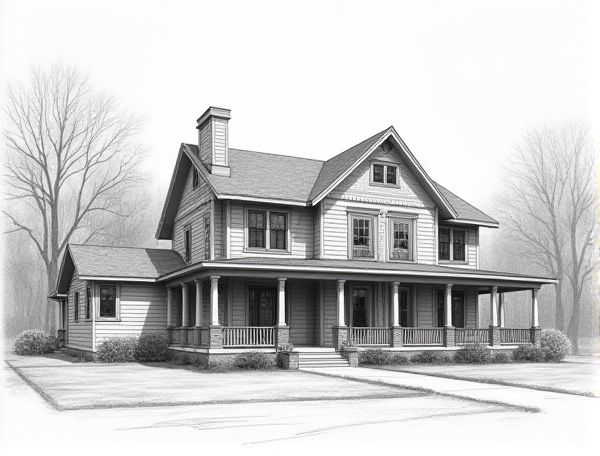
Photo illustration: Colonial revival home design with geothermal heat exchange
Colonial Revival home design seamlessly blends classic architectural elements with modern sustainability by integrating geothermal heat exchange systems that optimize energy efficiency and reduce environmental impact. Explore the full article to discover how you can enhance your home's comfort while preserving timeless style.
Introduction to Colonial Revival Home Design
Colonial Revival home design emphasizes symmetrical facades, evenly spaced windows, and classical details such as columns and pediments, drawing inspiration from American colonial architecture of the 18th century. This style often features brick or wood siding, gabled roofs, and decorative shutters, creating a timeless and elegant aesthetic for residential spaces.
Key Features of Colonial Revival Architecture
Colonial Revival architecture showcases symmetrical facades, multi-pane double-hung windows, and decorative entryways with pediments or fanlights. Prominent features include brick or wood siding, columned porches, and gabled roofs. Interior spaces often highlight detailed crown molding, fireplaces with mantelpieces, and hardwood floors that reflect historical American design.
The Evolution of Colonial Revival Homes
Colonial Revival homes have undergone significant evolution since their emergence in the late 19th century, blending traditional Georgian and Federal architectural elements with modern construction techniques. Key features such as symmetrical facades, columned porches, and multi-pane double-hung windows have been reinterpreted in contemporary designs to enhance energy efficiency and interior layout flexibility. This architectural style remains popular in suburban developments, reflecting a timeless aesthetic that balances historic charm with modern living needs.
Benefits of Geothermal Heat Exchange Systems
Geothermal heat exchange systems offer significant energy savings by utilizing the earth's stable underground temperature to efficiently heat and cool your home. This eco-friendly technology reduces reliance on fossil fuels, lowering greenhouse gas emissions and your overall carbon footprint. Enhanced durability and low maintenance requirements make geothermal systems a cost-effective choice for sustainable home design.
Integrating Modern Geothermal Heating in Historic Homes
Integrating modern geothermal heating systems into historic homes enhances energy efficiency while preserving architectural integrity by utilizing ground-source heat pumps that require minimal structural alterations. You can modernize your home's climate control sustainably, reducing energy costs and carbon footprint without compromising its historic character.
Energy Efficiency in Colonial Revival Residences
Colonial Revival residences incorporate energy-efficient features such as double-pane windows, enhanced insulation, and airtight construction to minimize heat loss and optimize HVAC performance. Strategic placement of windows and overhangs leverages natural light and passive solar heating, reducing reliance on artificial light and heating. Modern upgrades like ENERGY STAR-certified appliances and smart thermostats further enhance sustainability while preserving historic architectural integrity.
Preserving Architectural Integrity with Modern Upgrades
Preserving architectural integrity while integrating modern upgrades involves carefully selecting materials and design elements that respect the original style and craftsmanship of the home. Utilizing advanced technologies such as energy-efficient windows and smart home systems enhances functionality without compromising historical aesthetics. Maintaining original structural features, like crown molding and hardwood floors, ensures the home retains its authentic character alongside contemporary improvements.
Designing Geothermal Systems for Traditional Home Styles
Designing geothermal systems for traditional home styles requires careful integration to maintain architectural integrity while enhancing energy efficiency. Utilizing ground source heat pumps adapted to the classic foundation and insulation methods ensures optimal performance without disrupting historical aesthetics. Tailoring system components like ductwork and controls to fit period-specific spaces maximizes comfort and sustainability in heritage properties.
Case Studies: Colonial Revival Homes with Geothermal Solutions
Colonial Revival homes equipped with geothermal systems show impressive energy efficiency improvements, reducing heating and cooling costs by up to 50%. Case studies reveal that integrating geothermal solutions preserves the historical charm of Colonial architecture while ensuring sustainable comfort year-round. Your investment in this technology promotes eco-friendly living without compromising the timeless aesthetic of your home.
Future Trends in Sustainable Historic Home Renovation
Future trends in sustainable historic home renovation emphasize the integration of energy-efficient technologies such as solar panels, smart thermostats, and advanced insulation materials that preserve architectural integrity. Innovative approaches include using eco-friendly building materials like reclaimed wood and low-VOC paints to maintain historical authenticity while minimizing environmental impact. Embracing adaptive reuse and green building certifications ensures these renovations meet modern sustainability standards without compromising cultural heritage.
 homedesy.com
homedesy.com